Xin Luna Dong
CRAG-MM: Multi-modal Multi-turn Comprehensive RAG Benchmark
Oct 30, 2025Abstract:Wearable devices such as smart glasses are transforming the way people interact with their surroundings, enabling users to seek information regarding entities in their view. Multi-Modal Retrieval-Augmented Generation (MM-RAG) plays a key role in supporting such questions, yet there is still no comprehensive benchmark for this task, especially regarding wearables scenarios. To fill this gap, we present CRAG-MM -- a Comprehensive RAG benchmark for Multi-modal Multi-turn conversations. CRAG-MM contains a diverse set of 6.5K (image, question, answer) triplets and 2K visual-based multi-turn conversations across 13 domains, including 6.2K egocentric images designed to mimic captures from wearable devices. We carefully constructed the questions to reflect real-world scenarios and challenges, including five types of image-quality issues, six question types, varying entity popularity, differing information dynamism, and different conversation turns. We design three tasks: single-source augmentation, multi-source augmentation, and multi-turn conversations -- each paired with an associated retrieval corpus and APIs for both image-KG retrieval and webpage retrieval. Our evaluation shows that straightforward RAG approaches achieve only 32% and 43% truthfulness on CRAG-MM single- and multi-turn QA, respectively, whereas state-of-the-art industry solutions have similar quality (32%/45%), underscoring ample room for improvement. The benchmark has hosted KDD Cup 2025, attracting about 1K participants and 5K submissions, with winning solutions improving baseline performance by 28%, highlighting its early impact on advancing the field.
Stream RAG: Instant and Accurate Spoken Dialogue Systems with Streaming Tool Usage
Oct 02, 2025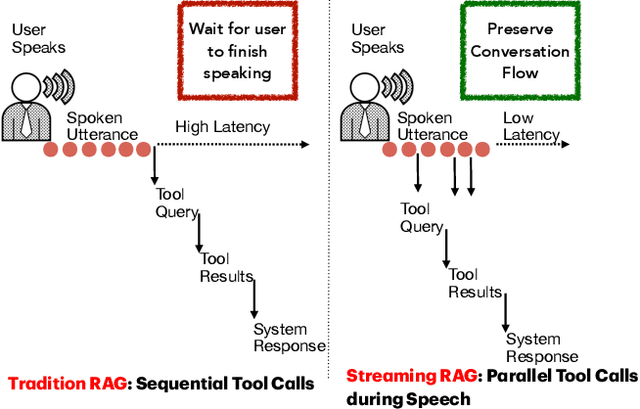
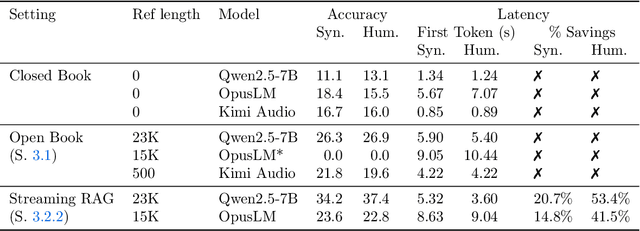
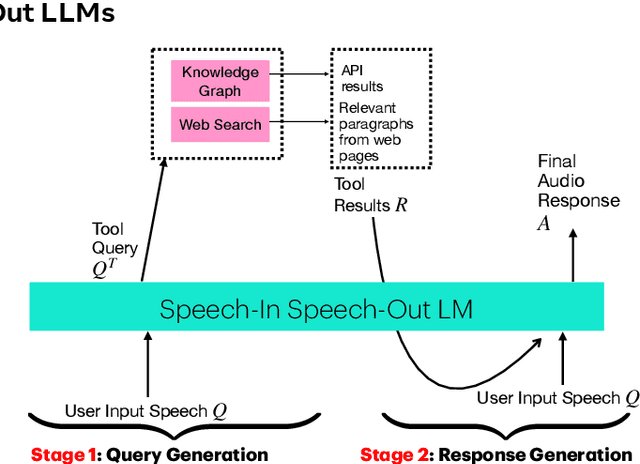
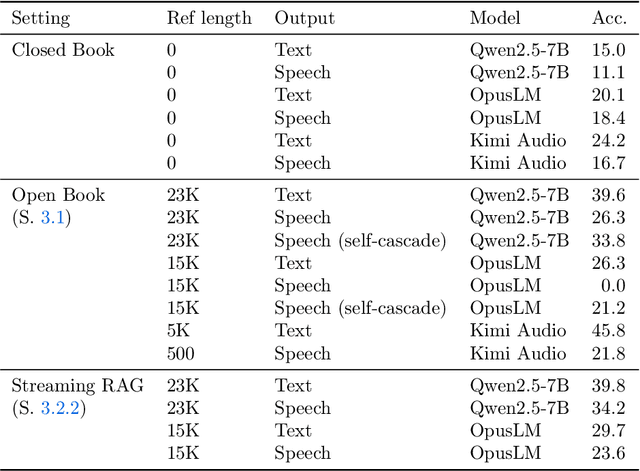
Abstract:End-to-end speech-in speech-out dialogue systems are emerging as a powerful alternative to traditional ASR-LLM-TTS pipelines, generating more natural, expressive responses with significantly lower latency. However, these systems remain prone to hallucinations due to limited factual grounding. While text-based dialogue systems address this challenge by integrating tools such as web search and knowledge graph APIs, we introduce the first approach to extend tool use directly into speech-in speech-out systems. A key challenge is that tool integration substantially increases response latency, disrupting conversational flow. To mitigate this, we propose Streaming Retrieval-Augmented Generation (Streaming RAG), a novel framework that reduces user-perceived latency by predicting tool queries in parallel with user speech, even before the user finishes speaking. Specifically, we develop a post-training pipeline that teaches the model when to issue tool calls during ongoing speech and how to generate spoken summaries that fuse audio queries with retrieved text results, thereby improving both accuracy and responsiveness. To evaluate our approach, we construct AudioCRAG, a benchmark created by converting queries from the publicly available CRAG dataset into speech form. Experimental results demonstrate that our streaming RAG approach increases QA accuracy by up to 200% relative (from 11.1% to 34.2% absolute) and further enhances user experience by reducing tool use latency by 20%. Importantly, our streaming RAG approach is modality-agnostic and can be applied equally to typed input, paving the way for more agentic, real-time AI assistants.
SCRIBES: Web-Scale Script-Based Semi-Structured Data Extraction with Reinforcement Learning
Oct 02, 2025
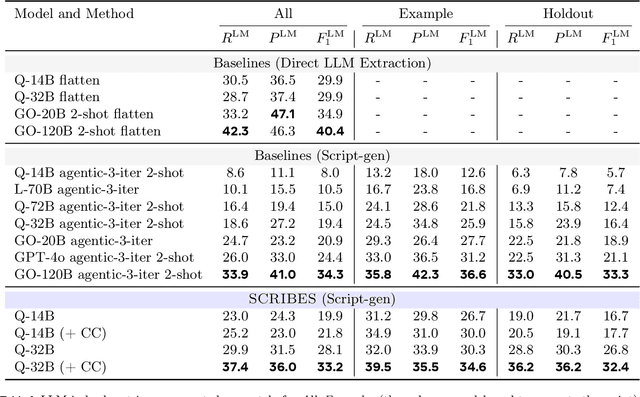


Abstract:Semi-structured content in HTML tables, lists, and infoboxes accounts for a substantial share of factual data on the web, yet the formatting complicates usage, and reliably extracting structured information from them remains challenging. Existing methods either lack generalization or are resource-intensive due to per-page LLM inference. In this paper, we introduce SCRIBES (SCRIpt-Based Semi-Structured Content Extraction at Web-Scale), a novel reinforcement learning framework that leverages layout similarity across webpages within the same site as a reward signal. Instead of processing each page individually, SCRIBES generates reusable extraction scripts that can be applied to groups of structurally similar webpages. Our approach further improves by iteratively training on synthetic annotations from in-the-wild CommonCrawl data. Experiments show that our approach outperforms strong baselines by over 13% in script quality and boosts downstream question answering accuracy by more than 4% for GPT-4o, enabling scalable and resource-efficient web information extraction.
KERAG: Knowledge-Enhanced Retrieval-Augmented Generation for Advanced Question Answering
Sep 05, 2025Abstract:Retrieval-Augmented Generation (RAG) mitigates hallucination in Large Language Models (LLMs) by incorporating external data, with Knowledge Graphs (KGs) offering crucial information for question answering. Traditional Knowledge Graph Question Answering (KGQA) methods rely on semantic parsing, which typically retrieves knowledge strictly necessary for answer generation, thus often suffer from low coverage due to rigid schema requirements and semantic ambiguity. We present KERAG, a novel KG-based RAG pipeline that enhances QA coverage by retrieving a broader subgraph likely to contain relevant information. Our retrieval-filtering-summarization approach, combined with fine-tuned LLMs for Chain-of-Thought reasoning on knowledge sub-graphs, reduces noises and improves QA for both simple and complex questions. Experiments demonstrate that KERAG surpasses state-of-the-art solutions by about 7% in quality and exceeds GPT-4o (Tool) by 10-21%.
ConfQA: Answer Only If You Are Confident
Jun 08, 2025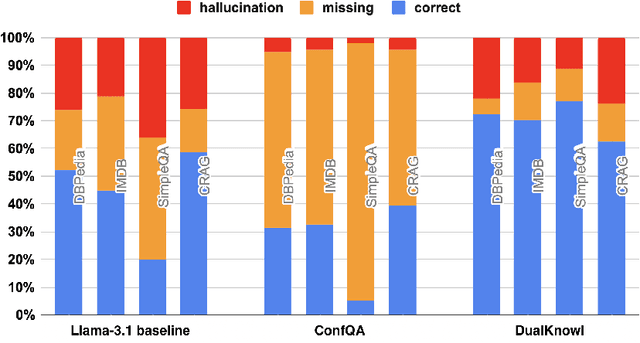

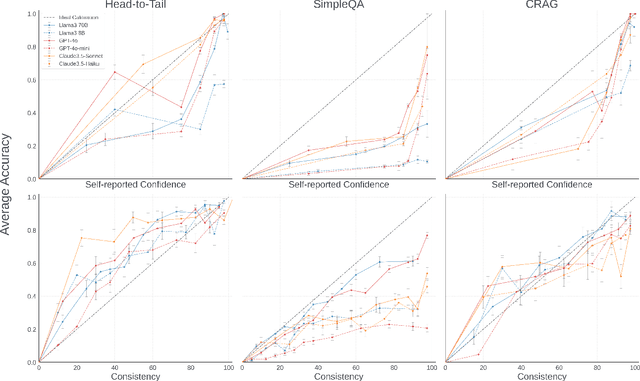
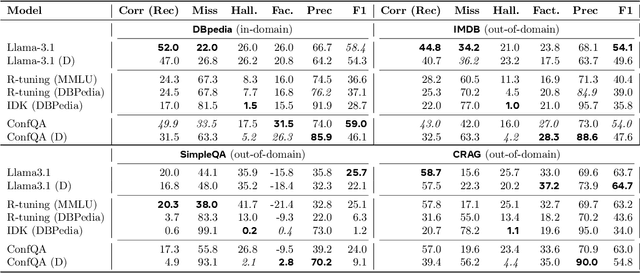
Abstract:Can we teach Large Language Models (LLMs) to refrain from hallucinating factual statements? In this paper we present a fine-tuning strategy that we call ConfQA, which can reduce hallucination rate from 20-40% to under 5% across multiple factuality benchmarks. The core idea is simple: when the LLM answers a question correctly, it is trained to continue with the answer; otherwise, it is trained to admit "I am unsure". But there are two key factors that make the training highly effective. First, we introduce a dampening prompt "answer only if you are confident" to explicitly guide the behavior, without which hallucination remains high as 15%-25%. Second, we leverage simple factual statements, specifically attribute values from knowledge graphs, to help LLMs calibrate the confidence, resulting in robust generalization across domains and question types. Building on this insight, we propose the Dual Neural Knowledge framework, which seamlessly select between internally parameterized neural knowledge and externally recorded symbolic knowledge based on ConfQA's confidence. The framework enables potential accuracy gains to beyond 95%, while reducing unnecessary external retrievals by over 30%.
Proactive Assistant Dialogue Generation from Streaming Egocentric Videos
Jun 06, 2025Abstract:Recent advances in conversational AI have been substantial, but developing real-time systems for perceptual task guidance remains challenging. These systems must provide interactive, proactive assistance based on streaming visual inputs, yet their development is constrained by the costly and labor-intensive process of data collection and system evaluation. To address these limitations, we present a comprehensive framework with three key contributions. First, we introduce a novel data curation pipeline that synthesizes dialogues from annotated egocentric videos, resulting in \dataset, a large-scale synthetic dialogue dataset spanning multiple domains. Second, we develop a suite of automatic evaluation metrics, validated through extensive human studies. Third, we propose an end-to-end model that processes streaming video inputs to generate contextually appropriate responses, incorporating novel techniques for handling data imbalance and long-duration videos. This work lays the foundation for developing real-time, proactive AI assistants capable of guiding users through diverse tasks. Project page: https://pro-assist.github.io/
Large Language Models, Knowledge Graphs and Search Engines: A Crossroads for Answering Users' Questions
Jan 12, 2025Abstract:Much has been discussed about how Large Language Models, Knowledge Graphs and Search Engines can be combined in a synergistic manner. A dimension largely absent from current academic discourse is the user perspective. In particular, there remain many open questions regarding how best to address the diverse information needs of users, incorporating varying facets and levels of difficulty. This paper introduces a taxonomy of user information needs, which guides us to study the pros, cons and possible synergies of Large Language Models, Knowledge Graphs and Search Engines. From this study, we derive a roadmap for future research.
VisualLens: Personalization through Visual History
Nov 25, 2024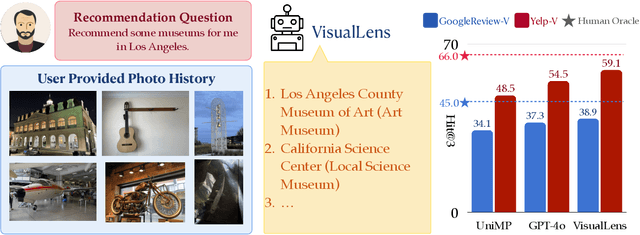

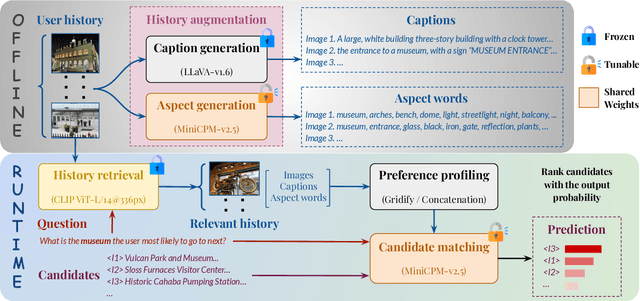
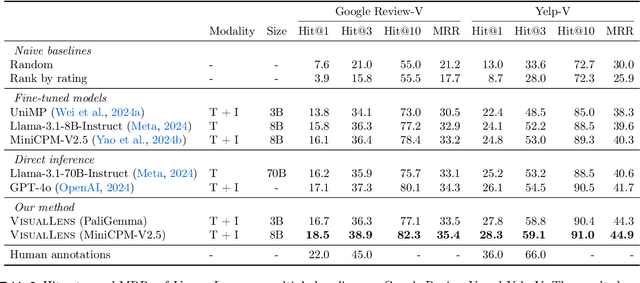
Abstract:We hypothesize that a user's visual history with images reflecting their daily life, offers valuable insights into their interests and preferences, and can be leveraged for personalization. Among the many challenges to achieve this goal, the foremost is the diversity and noises in the visual history, containing images not necessarily related to a recommendation task, not necessarily reflecting the user's interest, or even not necessarily preference-relevant. Existing recommendation systems either rely on task-specific user interaction logs, such as online shopping history for shopping recommendations, or focus on text signals. We propose a novel approach, VisualLens, that extracts, filters, and refines image representations, and leverages these signals for personalization. We created two new benchmarks with task-agnostic visual histories, and show that our method improves over state-of-the-art recommendations by 5-10% on Hit@3, and improves over GPT-4o by 2-5%. Our approach paves the way for personalized recommendations in scenarios where traditional methods fail.
Aligning Generalisation Between Humans and Machines
Nov 23, 2024



Abstract:Recent advances in AI -- including generative approaches -- have resulted in technology that can support humans in scientific discovery and decision support but may also disrupt democracies and target individuals. The responsible use of AI increasingly shows the need for human-AI teaming, necessitating effective interaction between humans and machines. A crucial yet often overlooked aspect of these interactions is the different ways in which humans and machines generalise. In cognitive science, human generalisation commonly involves abstraction and concept learning. In contrast, AI generalisation encompasses out-of-domain generalisation in machine learning, rule-based reasoning in symbolic AI, and abstraction in neuro-symbolic AI. In this perspective paper, we combine insights from AI and cognitive science to identify key commonalities and differences across three dimensions: notions of generalisation, methods for generalisation, and evaluation of generalisation. We map the different conceptualisations of generalisation in AI and cognitive science along these three dimensions and consider their role in human-AI teaming. This results in interdisciplinary challenges across AI and cognitive science that must be tackled to provide a foundation for effective and cognitively supported alignment in human-AI teaming scenarios.
Are Large Language Models a Good Replacement of Taxonomies?
Jun 17, 2024Abstract:Large language models (LLMs) demonstrate an impressive ability to internalize knowledge and answer natural language questions. Although previous studies validate that LLMs perform well on general knowledge while presenting poor performance on long-tail nuanced knowledge, the community is still doubtful about whether the traditional knowledge graphs should be replaced by LLMs. In this paper, we ask if the schema of knowledge graph (i.e., taxonomy) is made obsolete by LLMs. Intuitively, LLMs should perform well on common taxonomies and at taxonomy levels that are common to people. Unfortunately, there lacks a comprehensive benchmark that evaluates the LLMs over a wide range of taxonomies from common to specialized domains and at levels from root to leaf so that we can draw a confident conclusion. To narrow the research gap, we constructed a novel taxonomy hierarchical structure discovery benchmark named TaxoGlimpse to evaluate the performance of LLMs over taxonomies. TaxoGlimpse covers ten representative taxonomies from common to specialized domains with in-depth experiments of different levels of entities in this taxonomy from root to leaf. Our comprehensive experiments of eighteen state-of-the-art LLMs under three prompting settings validate that LLMs can still not well capture the knowledge of specialized taxonomies and leaf-level entities.
 Add to Chrome
Add to Chrome Add to Firefox
Add to Firefox Add to Edge
Add to Edge